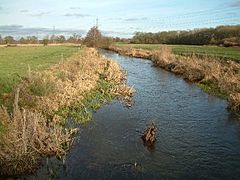River Allen, Dorset facts for kids
Quick facts for kids River Allen |
|
|---|---|

The river close to Furzehill
|
|
|
Location within Dorset
|
|
| Country | England |
| County | Dorset |
| Physical characteristics | |
| Main source | Monkton Up Wimborne, Dorset 50°55′15.1″N 1°58′52.6″W / 50.920861°N 1.981278°W |
| River mouth | Wimborne Minster, Dorset 50°47′33.4″N 1°58′43.3″W / 50.792611°N 1.978694°W |
| Length | 14 mi (23 km) |
| Basin features | |
| Basin size | 40 sq mi (100 km2) |
| Tributaries |
|
The River Allen is a river located in the county of Dorset in South West England. It flows for about 23 kilometers (14 miles). The River Allen joins the River Stour in a town called Wimborne Minster. It has two main smaller rivers, or tributaries, that flow into it: the Gussage Stream and the Crichel Stream.
Contents
The River Allen's Journey
The River Allen begins its journey at Wyke Farm. At first, it's a special type of stream called a winterbourne. This means it only flows during the wetter parts of the year. From there, it travels through Monkton Up Wimborne and past a watercress farm. It then continues to Honeybrook Farm and a mill, finally reaching Canford Bridge in Wimborne Minster, where it meets the River Stour.
The River Allen is known as a "chalkstream." This means its water flows over chalky ground, making it very clear and clean. These types of rivers are great for fishing, especially for trout. In the past, many salmon also lived here. A large part of the riverbanks is privately owned by two big estates, including the Shaftesbury Estate near where the river starts.
Old Watermills on the River
For many years, the River Allen powered several corn mills. These mills used the river's flow to grind grain into flour. One of these, Loverley Mill at Crichel, is still standing today. It's now a listed building, which means it's protected because of its historical importance.
Originally, Loverley Mill used two large water wheels. In the early 1900s, these wheels were replaced by a water turbine. This turbine used the river's power to pump water to Crichel House. Other mills along the river included Hinton Farm Mill, Stanbridge Mill, and Didlington Mill.
Protecting the River Allen
Since 1946, some of the River Allen's water has been taken for homes and factories. Taking too much water can harm the river's natural flow. When this happened, the number of salmon and trout in the river dropped a lot. Scientists studied this problem, and now less water is taken from the river, which helps it stay healthier.
Over the last twenty years, more farms have grown crops like wheat, barley, and peas near the river. Some watercress farms also operate nearby. Sometimes, water from these farms can flow into the river. The River Allen is part of a big project to restore it. This project is led by the Dorset Wildlife Trust, with help from Wessex Water and the Dorset Area of Outstanding Natural Beauty. They are working to keep the river clean and healthy for all its plants and animals.
River Life: Plants and Animals
The River Allen used to have the largest population of white clawed crayfish in Dorset. These are special native freshwater creatures. To help them, people planted trees and tried to slow down the river's flow. However, in 2014, a serious disease called Crayfish Plague was found in the river. Sadly, at least 100 native crayfish were found dead.
The river is also full of many different types of aquatic plants, called macrophytes. Two common ones are common water-crowfoot (Ranunculus aquatilis) and bur-reeds (Sparganium). Besides brown trout, the river is home to many other fish. These include minnow, dace, grayling, salmon, perch, roach, pike, bullhead, and brook lamprey. The critically endangered European eel also lives here.
How Healthy is the River Allen's Water?
The Environment Agency checks the water quality of rivers in England. They give each river an overall "ecological status," which tells us how healthy the river's environment is. This status can be high, good, moderate, poor, or bad. They look at things like the types and numbers of invertebrates (like insects and worms), flowering plants, and fish. They also check the "chemical status" by testing for different chemicals to make sure they are at safe levels. Chemical status is either good or fail.
In 2016, the River Allen's water quality was checked, and all parts of the river, including its main sections and its tributaries (Gussage Stream and Crichel Stream), were found to have a good ecological and chemical status. This means the River Allen is a healthy place for plants and animals to live!



